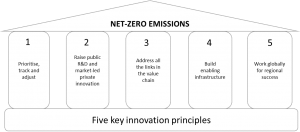By Timur Gül (Head of Energy Technology and Policy Division, International Energy Agency)
Araceli Fernandez Pales (Energy Technology Analyst, International Energy Agency)
Simon Bennett (Energy Technology Analyst, International Energy Agency)
Today the International Energy Agency (IEA) is sending a clear message to governments and companies around the world that clean energy innovation needs to accelerate to meet net-zero emissions goals. Our new Energy Technology Perspectives 2020: Special Report on Clean Energy Innovation presents new IEA modelling of pathways to a more resilient and cleaner energy sector at net-zero emissions, and explores the areas where critical technology solutions are in need of faster progress.
The report represents a new chapter in the IEA’s work under the Energy Technology Perspectives (ETP) banner. It has been three years since the IEA released its last ETP report, and we have used that time to reflect on the critical technology challenges that need to be addressed in such sectors as long-distance transport and heavy industry, which are all too often neglected.
When we started on this ETP-2020 journey last year, we certainly had not anticipated Covid-19 and how it has complicated efforts to advance clean energy transitions. However, by refocusing on the urgent need for technology progress and the potential setback presented by the impacts of the pandemic, the recommendations could not be more timely. There is a major opportunity to make investments in innovation that can stimulate economic recovery and help reshape the energy system to be more sustainable and resilient in the longer-term. On a path towards meeting sustainable energy and climate goals, we project that investments in technologies that are today at the stage of large prototype and demonstration would average around USD 350 billion a year over the next two decades.
The key technologies the energy sector needs to reach net-zero emissions are known, but not all of them are ready. Around 35% of the cumulative CO2 emissions reductions needed to shift to a sustainable path come from technologies currently at the prototype or demonstration phase. A further 40% of the reductions rely on technologies not yet commercially deployed on a mass-market scale.
To help guide policy makers and technology innovators, we have created a new online ETP Clean Energy Technology Guide that compares the market readiness of more than 400 component technologies relevant for net-zero emissions. The fastest energy-related examples in recent decades include small or modular consumer products like LEDs and lithium ion batteries, which took 10-30 years to go from the first prototype to the mass market, and benefitted from multiple spillovers between related technologies. These examples must be the benchmarks for building the portfolio of energy technologies to get to net zero emissions.
CO2 emissions reductions by technology readiness category in the Sustainable Development Scenario
 IEA 2020. All rights reserved.
IEA 2020. All rights reserved.
Notes: Percentages refer to cumulative emissions reductions by 2070 between the Sustainable Development Scenario and baseline trends enabled by technologies at a given level of maturity today.
Technologies that are at the prototype or demonstration stage today contribute more than one-third of the cumulative emissions reductions in the IEA Sustainable Development Scenario.
Around half of the cumulative emissions reductions that would move the world onto a sustainable trajectory compared to baseline trends come from four main technology approaches. These are the electrification of end-use sectors such as heating and transport; the application of carbon capture, utilisation and storage; the use of low-carbon hydrogen and hydrogen-derived fuels; and the use of bioenergy. However, each of these areas faces challenges in making all parts of its value chain commercially viable in the sectors where reducing emissions is hardest.
For governments aiming to achieve net-zero emissions goals while maintaining energy security, we propose five key innovation principles that we hope will help governments to integrate clean energy innovation into the heart of their energy policy making. Governments have a pivotal role that goes far beyond funding research and development. They set overall national objectives and priorities, and are vital in determining market expectations, ensuring the flow of knowledge, investing in essential infrastructure, and enabling major demonstration projects to go ahead. More information on each of these principles and practical application can be found in the report itself.
Key principles to accelerate clean energy technology innovation for net-zero emissions
IEA 2020. All rights reserved.
By applying five key principles, governments can compress the innovation cycle and deliver net-zero emissions.
Of note, the fifth principle recognises the importance of co-operation to share best practices, experiences and resources to tackle urgent and global technology challenges, especially via existing multilateral platforms like Mission Innovation. Over the coming weeks we will continue to work with Mission Innovation to convene governments that seek to build clean energy innovation into sustainable recoveries. Since the crisis erupted, the IEA has mobilised its resources to support governments and other energy stakeholders, notably with the publication of our Sustainable Recovery Plan that aims to ensure that the peak in CO2 emissions is already behind us. The ETP Special Report builds on that foundation by setting out the key priorities for innovation to continually drive emissions down from that peak and build a more resilient and cleaner energy sector at net-zero emissions. Together, the ETP and World Energy Outlook reports will provide the foundation for the IEA Clean Energy Transitions Summit on 9 July, which will bring together dozens of ministers and CEOs, as well as leaders from the investment community and civil society.
